In honor of the eighth (!) season of what is unfortunately my favorite reality television show, we need to talk about Selling Sunset. There’s a Sophia Amoruso-era brand of feminism running throughout the show that intrigues me. But this is neither a takedown nor a glamorization, rather a begrudging acknowledgment and dissection of the particular genius of this show and all of the labor that goes into it.
For those of you blissfully unaware of Selling Sunset (you’ve got eight seasons to catch up on!), here’s a brief overview: season one aired in March 2019, featuring a charmless set of identical bald twin brothers who own a ‘global real estate group’, which looks to the untrained eye like a harem of tall skinny women, at least three of whom one of the twins has dated (are you confused yet? Jason has dated Mary, Nicole, and Chrishell.) All of the space in the office is taken up by absurdly large desks, so there is only one couch, upon which all the women must sit for every team meeting.
The show’s format includes a generous tour of all the featured houses (against my will, I now know what book-matched marble is), which act as discordant backdrops for arguments and uncomfortable conversations. Each potential commission is superimposed over a drone shot of the property, further gamifying the work, almost begging the viewer to calculate how much that amount of money might change their financial situation (no? just me?).
As with all reality shows, each subsequent season ups the ante, necessitates more drama and excess, but I have to think that Selling Sunset’s accelerated evolution was at least partly due to the onset of the pandemic. Season two aired in May 2020. While it was filmed pre-pandemic, we were in the thick of lockdowns when it dropped, and it acted as a window into another world, one that was ostensibly reality but acted as fantasy—one where there weren’t makeshift morgues in freezer trucks parked down the street. Grown-up Barbies in cookie-cutter developer Dreamhouses extolled the virtues of 10,000 square feet of indoor-outdoor living as we watched from our sub-1000 square foot apartments in the same sweatpants we’d worn to bed, showed up to our outdoor spaces to find them locked and unavailable. Selling Sunset was an opportunity to try on other lives at a time when most of ours were incredibly constrained.
Below are what the clothes looked like in season one, which aired in 2019.
The outfits edge further and further into eyebrow-raising territory as the seasons stack up. And from season three onward, all bets were off—sartorially and otherwise—and the show settled into its identity as a surreal form of escapism, with costumes to match.
Now in its eighth season (which dropped on Netflix on September 5), Selling Sunset has become fully self-aware—its stars are shown breaking the fourth wall multiple times. There’s also a full plotline about ‘appropriate’ dress at a ‘broker’s open’ (we’ll get to that).
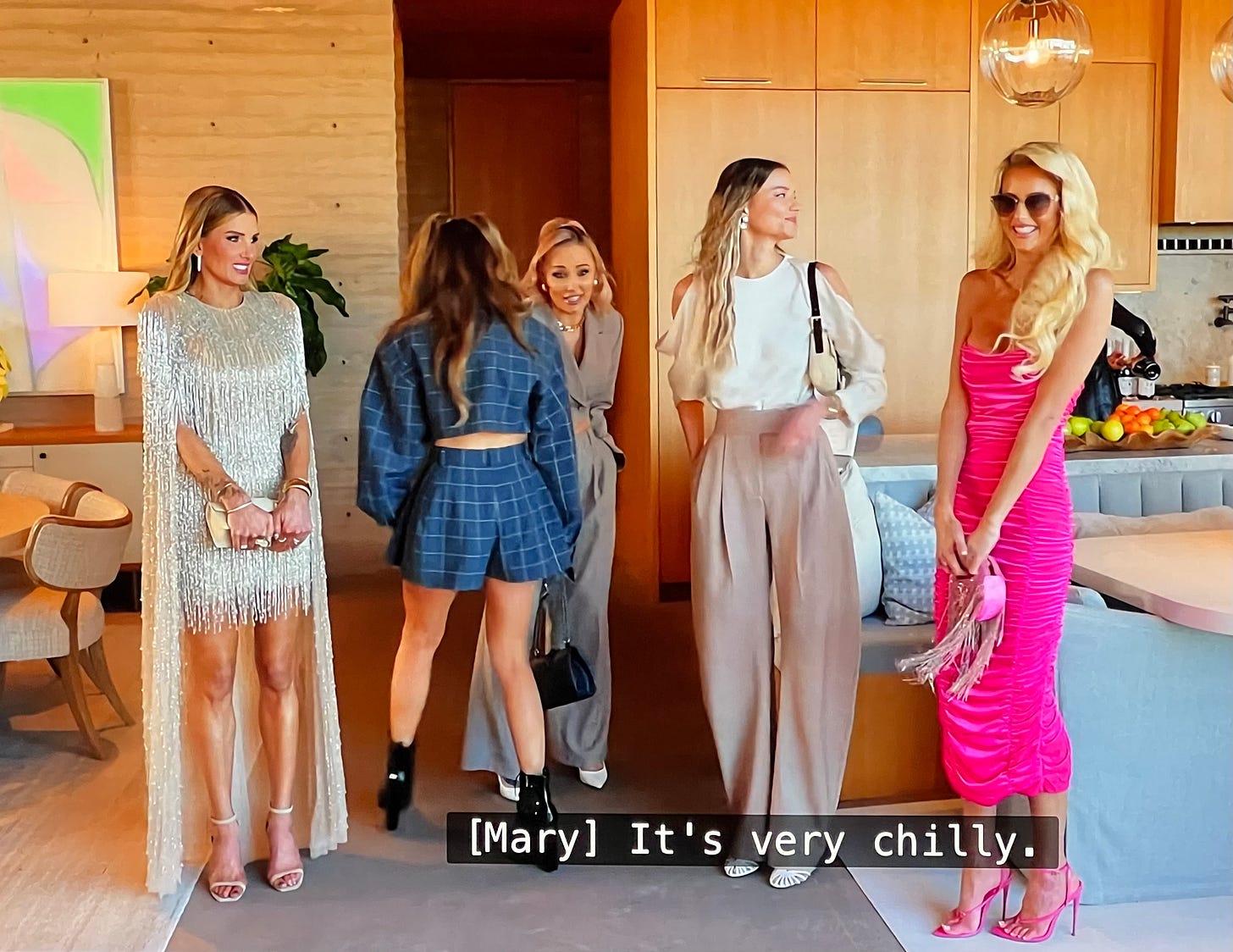
I absolutely believe that the women on this show are working hard, but not necessarily at the office, and not only on real estate. Everyone has manufactured a role for themselves through the vehicle of their appearance, and to keep that role, they must engage in constant maintenance. It makes sense—attention is currency. Maintaining an audience (in a world of increasingly fickle streaming viewership) means you get to return for the next season. More attention translates to more followers outside of the show, more brand deals, more visibility—more money.
“[T]he girls want to coordinate their look with the type of brands they want to work with, because brands will pay a client $20-30,000 to post one Instagram in one of their outfits to generate sales.” - stylist Sammie M, quoted in a Vice article
Of all the women on this show, Amanza is arguably the one person on this show for whom more money would be genuinely life-altering. She is a single parent whose ex-husband disappeared five years ago after failing to pay child support, she’s navigated adulthood largely on her own after enduring a childhood of abuse and neglect, and she’s dealt with some serious health issues and medical trauma over the last couple years. In season eight, Amanza sells her first painting and ends up with a gallery exhibition of her work. While her paintings may not be my style, watching Amanza realize that her notoriety may have opened the doors for a lucrative career of selling large abstract paintings to rich people was one of the more emotional moments of this season.
This is the cycle of Selling Sunset: appearance leads to attention leads to money, which gets invested back into appearance. Occasionally, the viewer is made privy to the money and effort that go into maintaining these appearances. A spray tan technician is hired to come to someone’s home. Bre convinces Chrishell to try an agonizing cold plunge. Mary goes into graphic detail about an unexpected surgery after one of her implants ruptures. The more famous these women get, the more work (completely separate from their jobs) they have to do to maintain that fame.
Now for the fun part… my impressions of the current cast from their season 8 wardrobes:
Mary is the down-to-earth one. Yes, the woman wearing those outfits is generally the voice of reason within the office. If there is one thing Mary won’t give you, though, it’s consistency. She’s leaned into the matching set as suit look for the last couple seasons, but that doesn’t mean she won’t turn up in a lace bodysuit or a sequined gown—and it’s an indication of her inability to decide whose side to take in almost every dispute that arises.
Bre likes nothing more than being different from the other girls. She’s tough, she’s edgy, she wears a literal dagger to the office. She’s projecting rebel, but in the end she falls prey to the same desire as everyone else on this show, which is, “I’m here to get my bag.” Bre is very purposeful about when she wants to turn it on and when she wants to be cloaked. There’s a perpetual question hovering around Bre: do you deserve to look at me or do you not? Her clothes also skew more masculine than most of the other women’s wardrobes, and it’s easy to see this as shorthand for her decision not to pursue romantic relationships on camera, her oft-stated pride in her own self-sufficiency.
Nicole has never looked comfortable on camera during the entire course of her time on this show. She’s been at the Oppenheim Group for ages, she’s likely one of the most competent agents, and I’ve always been curious why she decided to opt into appearing on the show, as it seems like it’s been one long nightmare for her. Nicole’s wardrobe is a mix of clashing jewel tones—I don’t think she owns anything that could be considered a neutral. This feels fitting, as Nicole has never remained neutral during a conflict on this entire show.
Emma is the embodiment of what I would call an almost violent femininity. She is Barbie incarnate, but to keep it interesting, she partners that aesthetic with the fearless spirit of a child playing with Barbies. In true Barbie fashion, armed with the knowledge that Barbies never die, Emma will move from impulse to action in a matter of seconds. She’s kooky! She walks along the edge of an infinity pool perched atop a steep cliff. She throws a rival empanada (this will take too long to explain) from the balcony of a luxury high rise. She takes her boss’s brand-new Ferrari (bought in cash, reportedly) for a joyride, despite not knowing how to drive stick.
Alanna is new this season, and trying to project confidence and competence without being showy. This is the first time I’ve seen a pair of jeans on this show in years. Of course, we’re shown multiple clips in which other cast members (Bre) are remarking on her “boring” and “vanilla” appearance. When Alanna’s competence is called into question, the black and white leather coat with the severe shoulders comes out, as both armor against these remarks and fortitude for the task ahead of her.
Chelsea is the agent whose outfit acts as a catalyst for a discussion about appropriate dress code at work events—truly the first time we have seen a discussion about this in the entirety of this show. It’s the cropped khaki blazer and matching “micro” skirt on the bottom left of that photo collage—both from a Korean brand called pushBUTTON, which you can find on SSENSE. While I don’t know that many people would find the length of this skirt appropriate for a work event, that’s not the point—it feels unfair to single out Chelsea for this outfit in the larger context of the show itself.
Chelsea has veered away from the pastels and over-the-top girly outfits of previous seasons, and spends most of season eight alternating between a vaguely dominatrix-ish black pleather aesthetic and a ‘dark academia’/office siren vibe (the glasses this season are killing me… I need to know if the lenses are prescription). It’s a more severe look, and I wonder if it evolved as a response to her ongoing conflict with Bre. As Chelsea’s personal life starts to unravel over the course of this season, the shift in color and tone begins to seem like a premonition.
Chrishell’s wardrobe has leaned hyperfemme for the last few seasons, but in season eight she’s adopted a look that borders on cartoonish in its exaggerated proportions and signifiers of youthfulness—huge clunky shoes with impossibly tall platforms, short flouncy skirts, pigtails and letterman jackets. As an out queer woman immersed in an environment where the male gaze is a form of currency, Chrishell pockets that currency, says “Thank you!” with a smile, then goes back home to G Flip, laughing all the way to the bank (unfortunately, I do stan this couple).
Amanza is both a beleaguered soul and a perpetual optimist. We just want her to catch a break! There’s no coherent throughline to Amanza’s clothing choices, but somehow you could easily pick her clothes out of a lineup if asked. (In the words of former Supreme Court Justice Potter Stewart, “I know it when I see it.”) From her triumphant birthday outfit (basically a see-through dress with almost nothing underneath—imagine wearing this to a party where both your children and your boss are in attendance) to her sparkly cowboy boots in preparation for a girls trip to Pioneertown, Amanza’s outfits are a glittery form of escapism, a manifestation of joy against all odds.
Even Jason and Brett’s style has evolved (so sorry, I’m going to refer to them as a duo even though I know Jason is featured more frequently—I’m 90% sure all of the photos above are of Jason.) Their outfits are much more label-conscious (Loewe, Gucci, Fendi, etc.) and logo-heavy than in earlier seasons. Jason has also moved from calling his employees “girls” to “ladies” most of the time, which feels like progress… or at least slightly less infantilizing.
So how do they get all of these clothes? Yes, there’s gifting from brands, but there’s not much in the way of a clothing budget coming from Netflix.
“They’re also only given a budget for outfits used in promotional photos and videos – they pay for everything else out of their own pocket. “I’m not going to name names,” Sammie says, “but some girls will pay between $5,000 to $10,000 for a custom-made outfit. Sometimes more. But we’re in Hollywood, and there’s a lot of access to rentals.” - Vice
Bre Tiesi echoes that information in a quote from People: “No budget… They don't help with anything, nor do they pay for any of it. I want to make that very clear.”
To swing those luxury looks, Tiesi reveals that the cast often does not outright buy the clothes featured on the show. In fact, they primarily “pull” the items from showrooms, wearing them on the show before returning them.
Sometimes, when the commission amount flashes over a cinematic view of the city, I daydream about what I’d wear if I made that kind of money. But I quickly remember that it’s impossible to untangle the financial freedom of the Selling Sunset girlies from the prison of their voluntary panopticon. And there is not enough money in the world that could get me to subject myself to that.
SOURCES:
https://people.com/bre-tiesi-selling-sunset-wardrobe-no-budget-netflix-exclusive-7564100
https://www.dailymail.co.uk/tvshowbiz/article-11678383/Selling-Sunsets-Amanza-Smith-Chelsea-Lazkani-stun-glam-outfits-step-LA.html
https://www.buzzfeednews.com/article/scaachikoul/selling-sunset-season-2-netflix-adam-divello
https://www.vice.com/en/article/selling-sunset-stylist-sammie-m-interview/
https://www.autostraddle.com/how-chrishell-stause-queered-selling-sunset/
https://www.autostraddle.com/top-15-gayest-moments-in-selling-sunset-season-seven/
https://www.popsugar.com/fashion/selling-sunset-outfits-47691607
https://www.instyle.com/selling-sunset-season-6-outfits-7505182
https://www.thedailybeast.com/obsessed/the-selling-sunset-season-7-outfits-are-more-ridiculous-than-ever
https://www.usmagazine.com/stylish/pictures/every-selling-sunset-season-8-outfit-that-had-us-talking/
https://people.com/selling-sunset-bre-tiesi-unveils-blonde-hair-8610790











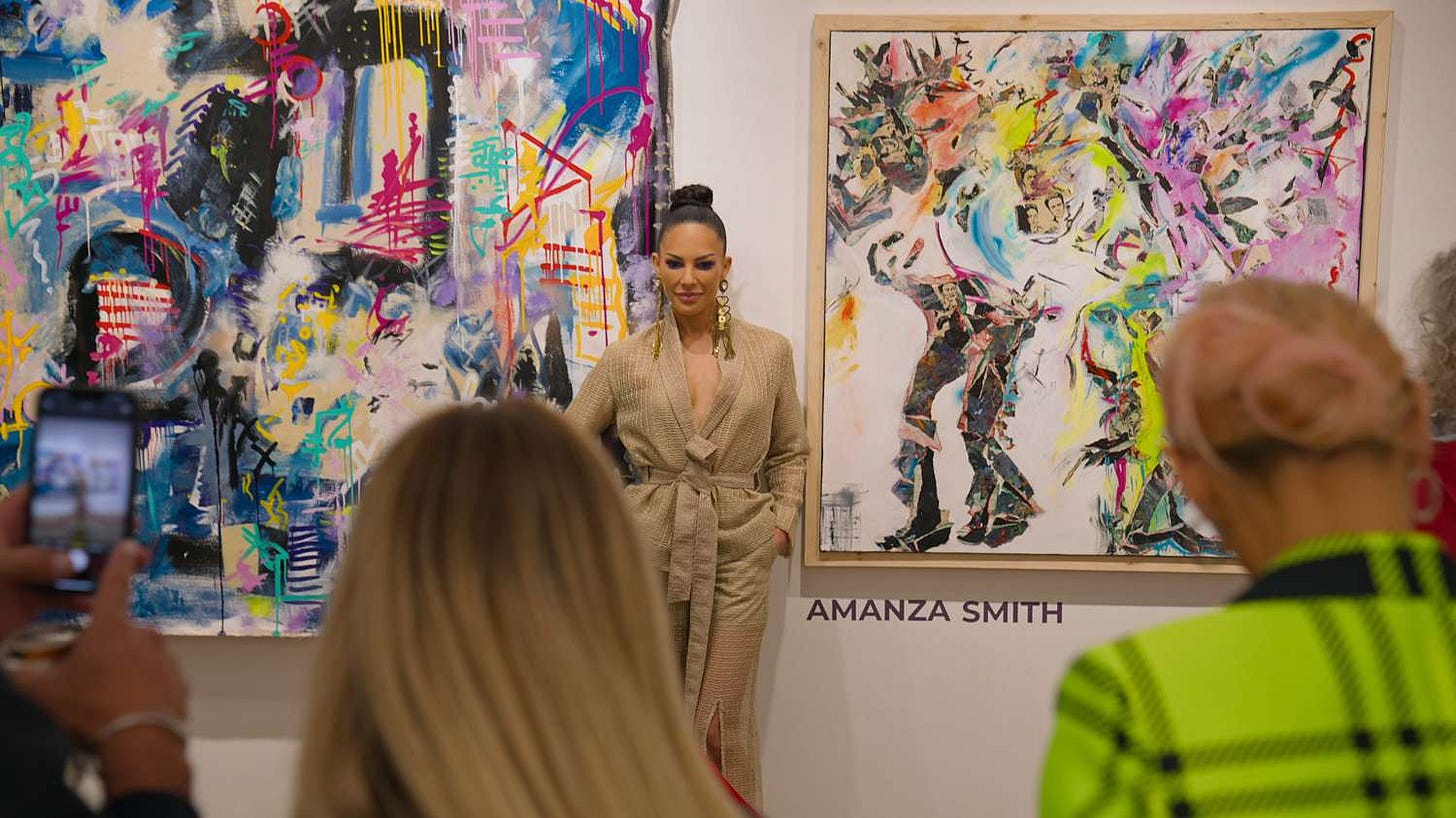



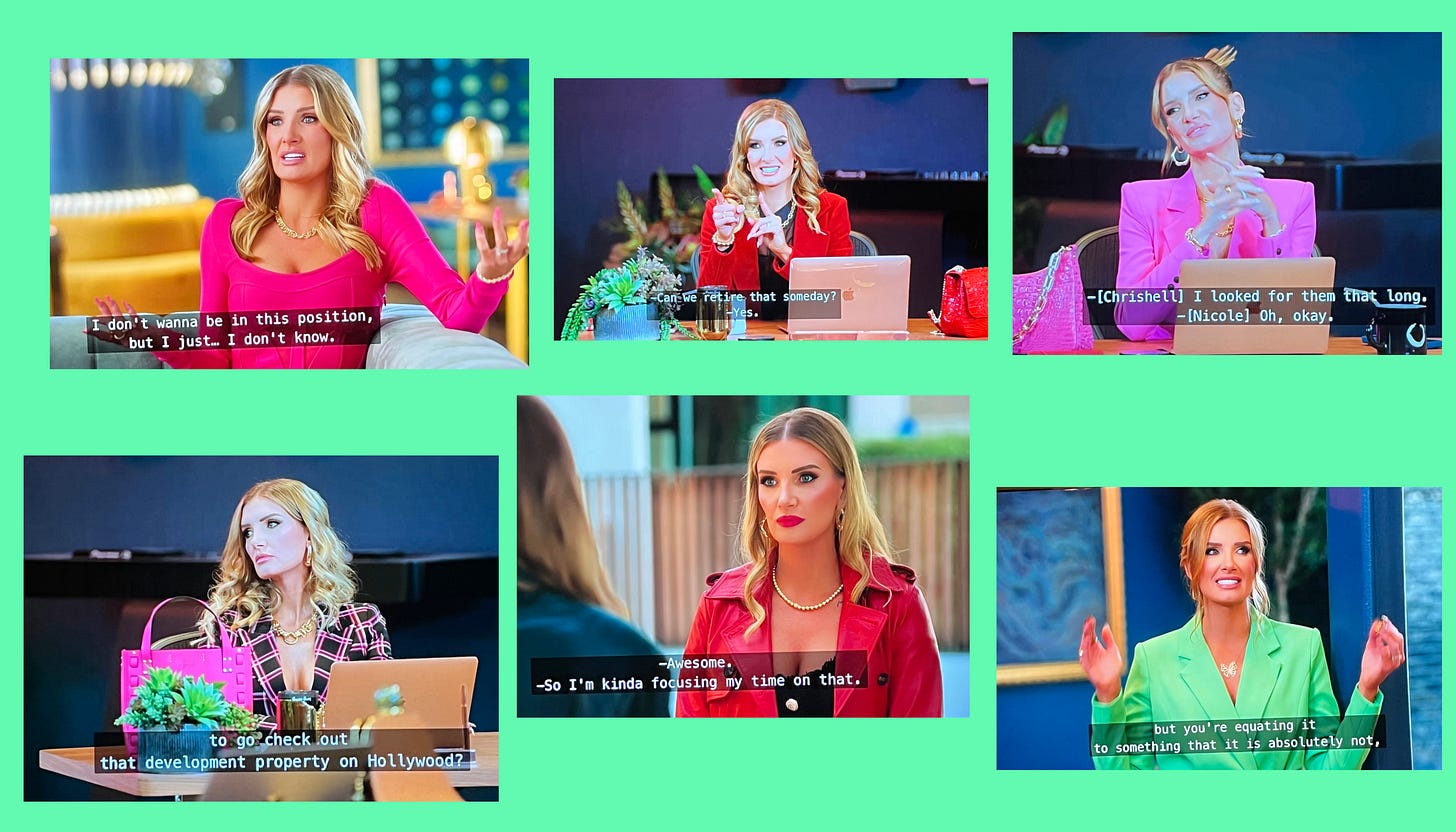


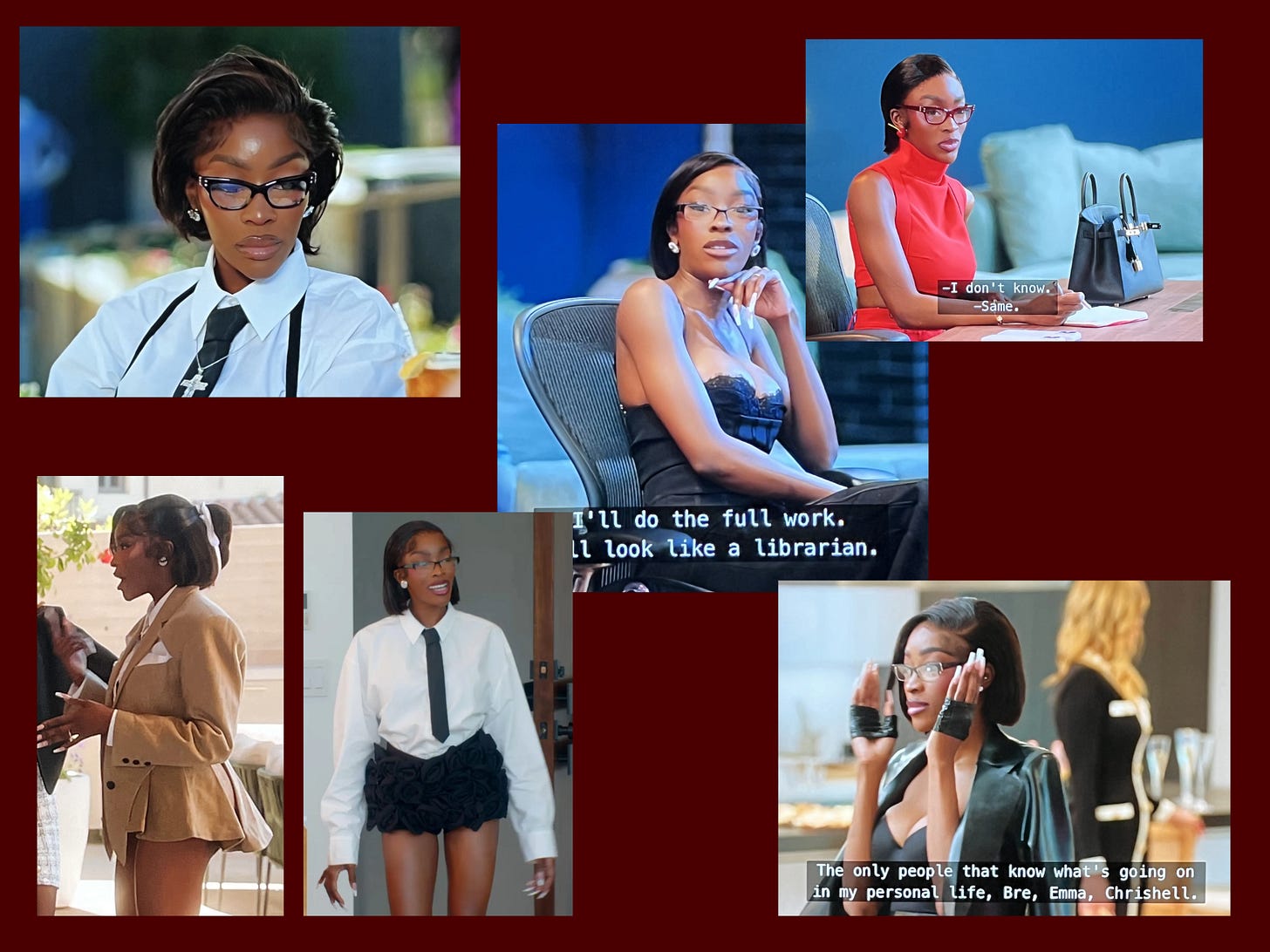

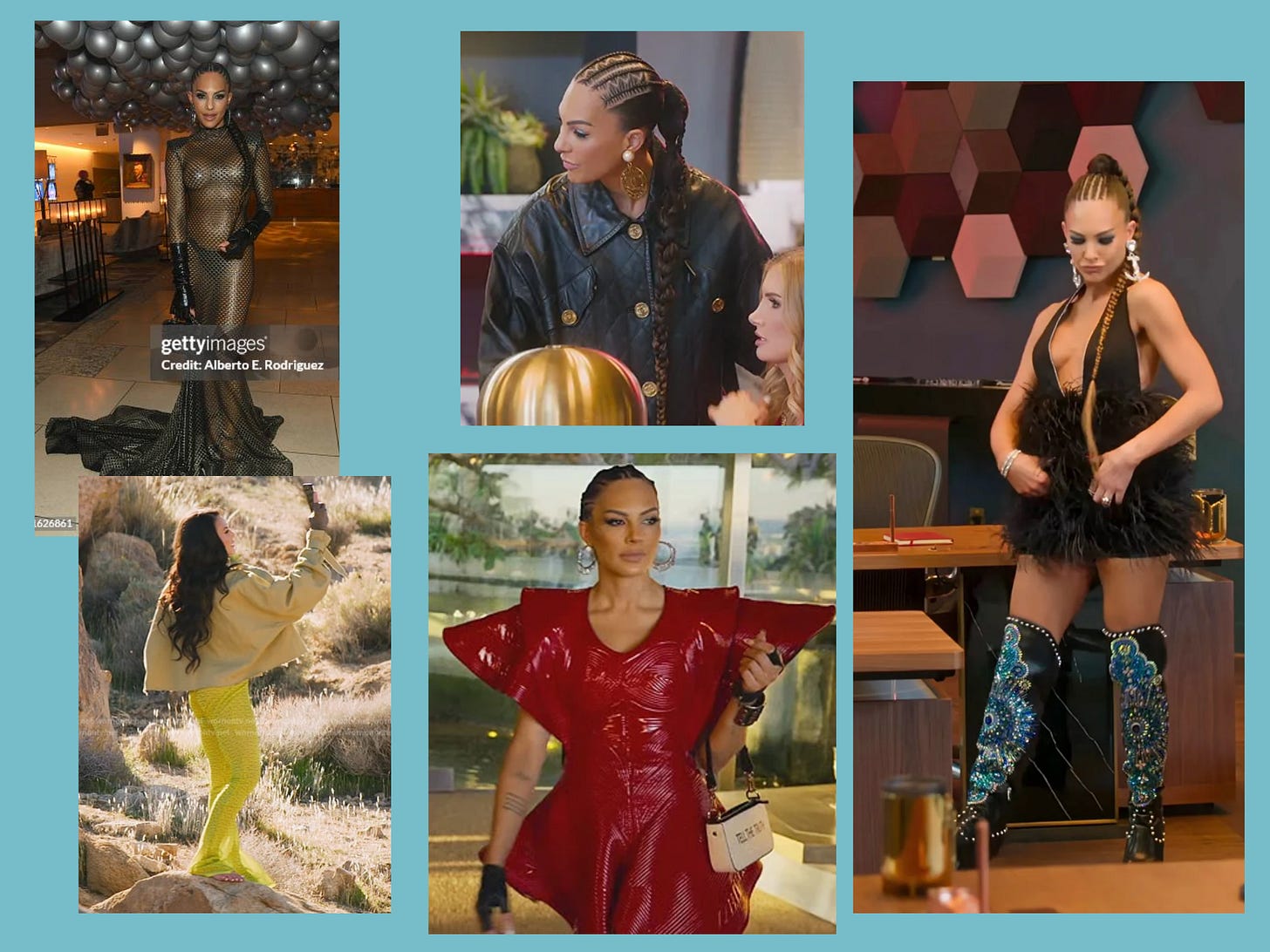
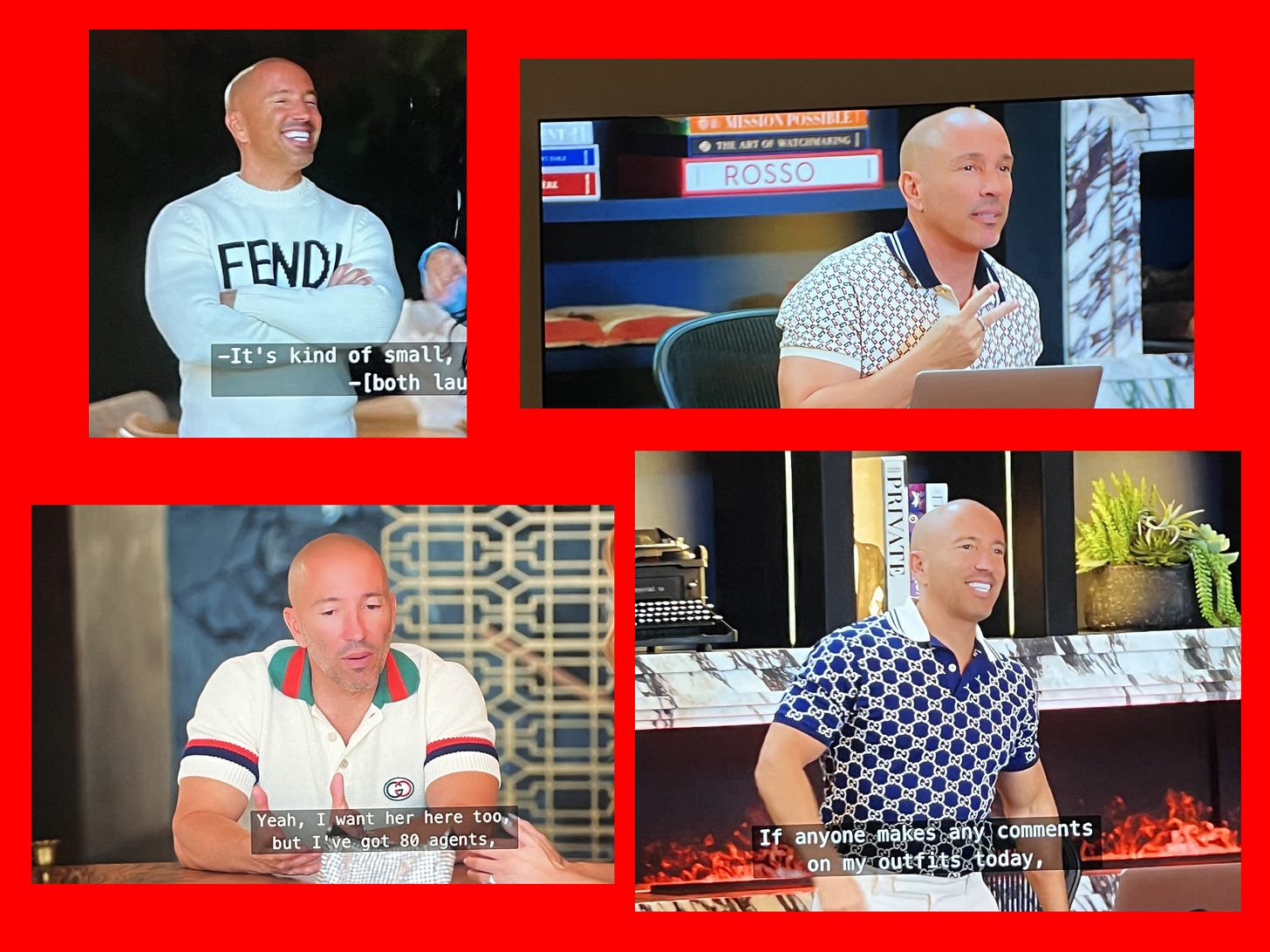

Fantastic post - I too am tragically a Selling Sunset enjoyer (tho I haven't watched Season 8 yet). Your description of Emma's "violent femininity" was spot on and made me lol. She freaks me out and is hands-down my least favorite cast member.
Your exploration of the clothes made me think about the interplay between fashion and architecture/interior design on the show as they've both evolved. The version of real estate presented on the show is obviously beyond morally indefensible - enormous, environmentally destructive mansions being bought and sold by people who view them as financial assets more so than places to live, largely leaving them empty in a city with a massive housing crisis. Relatedly, my favorite moments on the show are when they (infrequently) run up against real-world checks on the speculative real estate market, always framed as an unfortunate barrier to be overcome by hustling - the mansion tax, absurdly high fire insurance, etc.
As the show has gone on, they've had to come up with more and more huge and expensive houses to maintain shock value, but I can never get over how identically soulless and styleless all of these places are. They are ugly!! Though I too have looked at the real estate agent commissions with envy (lol, duh), I don't think I've ever once wished that I got to live in one of these enormous, slapped-together, beige, digital-rendering-ass mansions. The clothing and the real estate have escalated in tandem, revealing a deep vacancy at the heart of the world that the show depicts: enormous, expensive houses vacant of style or beauty; outlandish, "sexy" clothes vacant of real sex appeal or clear relationship to the situations in which they are worn. I've noticed that the women actually make pretty frequent reference to the costumeyness/practical difficulties of whatever insane thing they're wearing. The ugliness/homogeneity of the houses, however, cannot be acknowledged in the world of the show because ostensibly the O Group is an actual business. Anyway, I didn't think I was going to write a multiple-paragraph musing on Selling Sunset today, so thank you Eleanor for providing the opportunity haha!
Holy shit this is one of my fave newsletters to date?! I have never seen the show (though obv I *have* read multiple articles abt g-flip & chrishell and Also Stan) but now I want to watch just to observe the dynamics, so that’s some incredibly persuasive writing!! Also “violent femininity” is just a perfect descriptor for this brand of aggressively performative and explicitly transactional femininity. Such a great read 💯💯